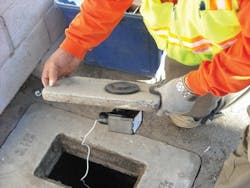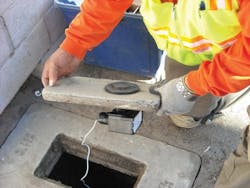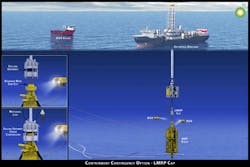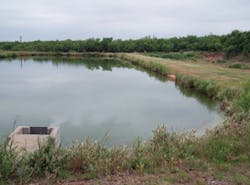New System Offers Total Nitrogen Removal Without Carbon Source
In Europe, the DEMON® process has been used at more than 20 wastewater treatment plants to remove more than 80 percent of the total nitrogen from pressate or centrate from solids dewatering. The technology is based on a biological process of partial nitritation and autotrophic nitrite reduction. It was developed and patented by the University of Innsbruck, Austria. The system has recently been introduced to the North American market by World Water Works.
By Chandler Johnson
In recent years total nitrogen removal has become one of the most significant cost factors a wastewater facility faces. To comply with progressively stricter Environmental Protection Agency (EPA) and state regulatory agency rules, facilities are confronted with major plant upgrades that include nitrification and denitrification. These systems typically require significant space, substantial capital upgrades, and impact both energy and chemical operational costs.
An analysis of the mass balance of a wastewater treatment plant reveals that up to 40 percent of the nitrogen load into a plant can come from the dewatering pressate or centrate stream return line. There is a direct relation between the efficiency of the wastewater solids digestion process and the release of ammonia. This effect is visible in the ammonia concentrations of liquors produced in the dewatering of digested biosolids.
The pressate or centrate from these dewatered solids is returned to the head of the plant. Treating this side stream can have significant advantages with tremendous overall economic impact.
In Europe, a process called the DEMON® System has been successfully implemented on over 20 plants removing more than 80 percent of the total nitrogen on this side stream. DEMON is an acronym for DEamMONnification. The technology is based on a biological process of partial nitritation and autotrophic nitrite reduction. The process was developed and patented by the University of Innsbruck, Austria.
The system has recently been introduced to the North American market by World Water Works, Inc.
Traditional Nitrogen Removal
Traditional wastewater nitrification/denitrification typically requires large amounts of energy and carbon to obtain low effluent nitrogen limits. Alkalinity is sometimes required to maintain an efficient system while extra sludge is produced due to the use of an external carbon source. Operational dissolved oxygen levels range from 1.0 to 2 mg/L.
Nitrification is the process by which ammonium (NH4+) or ammonia (NH3) is oxidized into nitrite (NO2-) by ammonia-oxidizing bacteria (AOB), often Nitrosomonas spp, and the NO2- is further oxidized into nitrate (NO3-) by nitrite-oxidizing bacteria (NOB), often Nitrobacter spp.
Within the two processes of nitrification - nitritation and nitratation - the bacterial groups are both chemo-litho-autotrophic, meaning their only energy source is chemical energy. Their electron-donor is an inorganic compound and their carbon source is carbon dioxide (CO2), or functionally bicarbonate (HCO3-).
Shortcutting the Nitrogen Cycle
The DEMON system involves two process steps - the partial nitritation of ammonia and the subsequent anoxic oxidation of the residual ammonia and nitrite to nitrogen gas. About half the amount of ammonia is oxidized to nitrite and then residual ammonia and nitrite is anoxically transformed to elementary nitrogen.
Both process steps are catalyzed by different groups of organisms: a population of aerobic autotrophic ammonia oxidizers, and a consortium of anaerobic autotrophic ammonia oxidizers (anammox) whose intensely red color is typical.
By reducing the amount of ammonia being converted to nitrite, only 40 percent of the energy used by conventional nitrification is required. Additionally, no external carbon source (methanol) is needed due to the autotrophic nature of the process.
The method technically is performed in a sequencing batch reactor (SBR) plant in which the individual steps take place in a timely sequence. The reactor is first gradually filled with centrate and the content is alternately aerated and mixed. Nitritation occurs during aerated periods and deammonification occurs during anoxic/anaerobic periods. At the end of the fill and aerate phase, both aeration and mixing are stopped and the sludge blanket is allowed to settle. The clear supernatant is then discharged from the reactor. As the de-ammonifying bacteria have excellent settling characteristics, the discharge system is simple. At the end of the discharge phase, the reactor is ready for the next cycle.
The process generates a sludge that forms dense pellets (1,010 cells per ml). The growth rate of this sludge is very low, requiring a mandatory high sludge retention time. Although growth is slow, the sludge is quite resilient. For wastewater treatment plants newly starting with the process, a concentrated quantity of anammox sludge is provided to accelerate the startup process.
Process Controls
DEMON is designed as a fully automated process with a patented control strategy. Finely-tuned process controls are critical to closely monitor operating parameters and maintain consistent effluent conditions. Operator participation is limited to adjustment of sensors for pH, oxygen, ammonia and volume of sludge. No chemicals are added.
The control system is based on minute variations in pH, resulting in a very simple and stable process operation. The established bandwidth for pH fluctuation is approximately 0.1 pH units. During the fill and aerate phase the reactor is alternately aerated to convert ammonia into nitrite, which causes the pH to drop. When aeration is stopped the pH rises. The aeration is then restarted and the cycle is repeated.
It is the relative change in pH value that is critical. Nitrite oxidizing bacteria compete with anammox for the available nitrite, producing changes in pH that are used to monitor nitrite production. The measurement of relative changes in pH over a short time period is accurate enough to control the process.
Anammox Biomass Enrichment
A significant feature of the DEMON process is its patent-pending cyclone device for additional enrichment of the specialized slowly growing anammox biomass.
Since anammox is predominantly aggregated in a heavy granular fraction, the cyclone-produced centrifugal forces select the anammox populations while wasting the AOB/NOB populations and decouple the sludge retention time (SRT) from the system’s operation. The substantially higher mass of anammox in the system compensates for the slower kinetics of these organisms compared to AOBs. This surplus in retention of compact red granules enhances process robustness and treatment capacity.
Doubling the mass ratio of anammox compared to aerobic AOB helps improve the robustness of the process against disturbances like over-aeration, temperature drop or a flush of excess organic carbon.
Ammonia Removal Efficiency
The DEMON process can be successfully applied for the removal of ammonia from sludge liquors, without the need for an external carbon source or any other chemical. The use of a cyclone in the process allows for different sludge retention times (SRTs) and for different types of bacteria, thus greatly enhancing process stability.
Centrates can show large variations in ammonia concentration, which are mainly caused by different batches of biosolids being digested. Despite these variations, the DEMON process operates consistently with an ammonia removal efficiency of 85 to 92 percent. This reduction in ammonia load is a critical benefit to the main treatment process.
Because dosage of external carbon can be completely avoided, the amount of excess sludge produced is extremely small and the corresponding disposal costs are minimized.
About the Author: Chandler Johnson is Chief Technology Officer with World Water Works. He is respected globally for his knowledge and expertise in wastewater biological processes and specifically Moving Bed Biofilm Reactor (MBBR) and Integrated Fixed-Film Activated Sludge (IFAS) design and implementation. Johnson has a Master’s in Environmental Engineering from Rensselaer Polytechnic Institute (RPI) and BS in Civil/Environmental Engineering from University of Wisconsin.
More WaterWorld Current Issue Articles
More WaterWorld Archives Issue Articles



